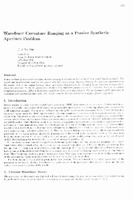| dc.contributor.author | Sullivan, Edward J. | |
| dc.date.accessioned | 2018-10-11T14:08:23Z | |
| dc.date.available | 2018-10-11T14:08:23Z | |
| dc.date.issued | 1997 | |
| dc.identifier | 11509 | |
| dc.identifier.govdoc | CP-45 | |
| dc.identifier.uri | http://hdl.handle.net/20.500.12489/468 | |
| dc.description.abstract | A new method of wavefront curvature passive ranging is introduced that is based on a model-based approach. The signal and measurement systems are placed into state-space form, thereby allowing the unknown parameters of the model, such as the signal bearing, range, and source frequency to be estimated by an extended Kalman filter. Since the processor treats the parameters of interest as unknown parameters to be estimated, there is no explicit beamformer structure. After a theoretical exposition of the underlying theory. The performance of the processor is evaluated with synthesized data sets. The results indicate that the method is a highly effective approach. | |
| dc.format | 6 p. : ill. ; digital, PDF file | |
| dc.language | English | |
| dc.publisher | NATO. SACLANTCEN | |
| dc.source | In: High Frequency Seafloor Acoustics (SACLANTCEN Conference Proceedings CP-45), 1997, pp. 533-538 | |
| dc.subject | Synthetic Aperture Sonar (SAS) | |
| dc.subject | Signal processing | |
| dc.subject | Kalman filtering | |
| dc.subject | Acoustic models | |
| dc.subject | Sonar mathematical models | |
| dc.title | Wavefront curvature ranging as a passive synthetic aperture problem | |
| dc.type | Papers and Articles | |
| dc.type | Conference Proceedings (CP) | |
